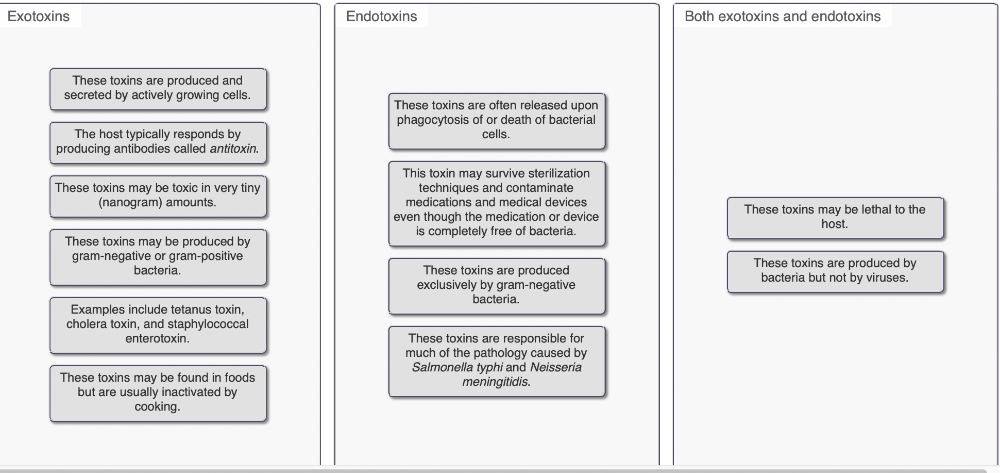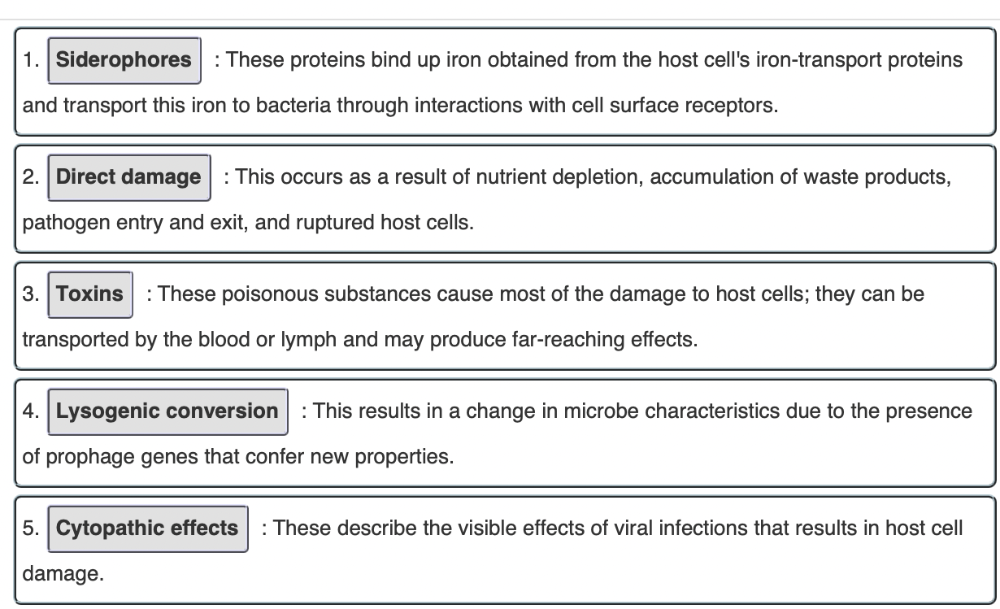In mice, the LD50 for staphylococcal enterotoxin is 1350 ng/kg, and the LD50 for Shiga toxin is 250 ng/kg. Which of the following statements is true?
Shiga toxin is more lethal than staphylococcal enterotoxin.
Which of the following would be an example of an infection initiated via the parenteral route?
An individual contracts hepatitis B from an accidental stick with a contaminated needle.
Which of the following statements about adherence is true?
Most bacterial adhesins are glycoproteins or lipoproteins.Submit
Which type of bacterial enzyme helps spread Streptococcus pyogenes by digesting blood clots?
fibrinolysin
In which of the following cases would the Limulus amebocyte lysate (LAL) assay be used?
to ensure that a sterilized medical device is free of endotoxin
In January 2010, a devastating earthquake struck Haiti about 15 miles west of the capital city of Port-au-Prince. The earthquake killed over 200,000 people and displaced over 1 million from their homes. Many of these people had nowhere to go other than displacement camps and shantytowns, where the sanitary conditions were less than ideal. It was not only private homes that were destroyed; hospitals, communication networks, land and air transport, and other important infrastructure were damaged.In October 2010, a cholera epidemic was reported in the Artibonite Department (Haitian departments are analogous to states). This was the first cholera epidemic in Haiti in over a century. Within 10 weeks, cholera had spread to all Haitian departments. By the end of the epidemic, more than 470,000 cases had been reported, and more than 6500 people were dead.Both during and after the epidemic, epidemiologists, doctors, and scientists were working to determine the source of the outbreak and its transmission patterns, identify the causative strains, and care for the infected.
The ability of Vibrio cholerae to cause disease depends on a number of factors. Which of the following are general requirements for any organism to cause disease within a host?
adherence to host tissues
gaining access to the host via a portal of entry
evasion of host defenses
Some studies have indicated that the ID50 for Vibrio cholerae can be as high as 108 organisms. Which of the following most likely explains the requirement for this relatively high ID50?
To establish infection, V. cholerae must survive the host immune response and the acidic environment of the stomach.
Which of the following are properties of exotoxins?
Very small amounts of exotoxin can be lethal.
Exotoxins are protein molecules.
Exotoxins target specific cellular structures or molecules.
The physical symptoms of cholera present only after a specific series of events has taken place. What is the most likely sequence of events in the pathogenesis of V. cholerae?

Although cholera can be treated with antibiotics, data suggest that antibiotic treatment alone is NOT the most effective therapy. Which of the following statements describes the most likely reason for supplementing antibiotic therapy?
Antibiotic therapy addresses only the growth of V. cholerae; it doesn’t address the extreme dehydration suffered by a person infected with V. cholerae.
Disease research and epidemiology bring together many different facets to help us better understand disease pathology and spread. Which of the following statements are true?
Some pathogens are able to cause disease within a host without penetrating the body.
The interactions that occur between a microbe and host influence the evolution of both.
Exotoxins and endotoxins are two fundamentally different types of bacterial toxins. In this activity, you will determine whether each of the following statements applies to exotoxins or endotoxins. Some statements may apply to both types of toxins.

The majority of exotoxins are A-B toxins, which are composed of two polypeptide subunits referred to as A and B. The B component functions to bind or attach to the host cell, whereas the A component exerts its toxic effects on the cell. This activity asks you to place the images in the correct order as they occur when an A-B toxin interacts with the host cell.

Which of the following strategies might be used to block the activity of an A-B toxin?
blocking host cell receptors to which A-B toxins bind
blocking receptor-mediated endocytosis in cells targeted by the A-B toxin
blocking the binding sites on the B portion of an A-B toxin
Considering the pathology of a cytokine storm, select possible strategies that would be likely to diminish the harmful effects of superantigen toxins.
blocking secretion of proteins by bacterial cells
blocking the release of cytokines from T cells
blocking molecular determinants on superantigens that interacts with T cells
neutralizing circulating cytokines
Consider the structure of a plasma membrane. Select the mechanisms through which a toxin is likely to disrupt the plasma membrane of a host cell.
disruption of phospholipid bilayer
insertion of a protein channel in the host cell plasma membraneSubmit
Select the statements that correctly describe endotoxins.
Sterilized items may contain endotoxins and cause a reaction in a patient.
Symptoms caused by endotoxins may actually worsen after treatment of an infection caused by gram-negative bacteria.
Endotoxins can cause fever, chills, weakness, and fatigue.
Endotoxins may cause a life-threatening drop in blood pressure known as endotoxic shock.Submit
Endotoxin is well known for its ability to produce a pyrogenic response (fever). Place in the correct order the steps by which gram-negative bacteria may bring about fever response.

In this activity, you will identify portals of entry and exit found in a human host.
-
- mucous membrane
- skin
- parenteral route
In this activity, you will view scenarios for the initiation of an infection and determine whether they relate to the number of invading microbes or adherence to the host tissue.

Bacillus anthracis can cause infection via three different portals of entry. The ID50 of cutaneous anthrax is 10 to 50 endospores, whereas inhalation anthrax requires 10,000 to 20,000 endospores, and gastrointestinal anthrax requires 250,000 to 1,000,000 endospores. Which statement best describes a conclusion that can be drawn based on this information?
It is significantly easier to be infected with cutaneous anthrax as compared to other forms of anthrax.Submit
In this activity, you will match each factor that influences a pathogen’s ability to penetrate or evade host defenses with its best description.

In this activity, you will consider several scenarios and determine whether infection is likely or unlikely to occur.Reviewing the overall microbial mechanisms of pathogenicity (Figure 15.9), predict the ability of the pathogen to cause infection in each of the following scenarios.

Endotoxins are also known as
Lipid A.
When would endotoxins be released from a bacterial cell?
When the cell dies
Which of the following would be the first sign of an infection that resulted in the release of endotoxin?
Fever
Why is a release of endotoxin into the bloodstream potentially deadly?
It can lower blood pressure and cause the patient to go into shock.
Which of the following features of Salmonellaprevent it from being phagocytosed?
FlagellaSubmit
Where do Salmonellapathogens grow and replicate in the infected host?
Inside
Where is the site of Shigellaattachment in the host?
M cells
How do Shigellacells move between host cells?
They can polymerize actin molecules from the epithelial cells into tail-like structures that propel them from one cell to another.
What is the etiologic agent of typhoid?
Salmonella
An exotoxin that has the ability to kill or damage host cells is referred to as a(n)
cytotoxin
Which domain of the A-B toxin binds to cell surface receptors on the host cell?
B domainSubmit
How are superantigens different from other types of exotoxins?
Superantigens cause an overstimulation of the host immune system.Submit
A person who attended a picnic early in the day develops a very high fever and is unresponsive by the evening. This person most likely has been exposed to a(n)
superantigen
A patient who has been hospitalized with uncontrolled muscle spasms has probably been infected with bacteria that secrete a(n)
neurotoxin
How are immune cells able to detect foreign pathogens?
They are able to detect structures on the surfaces of foreign cells that are not found in the host.
How does a capsule help certain bacteria evade detection by the immune system?
The capsule is composed of polysaccharides that are similar to those found in the host; thus, the immune system does not recognize it as foreign.Submit
Which of the following microorganisms actually grows inside the macrophage?
Tuberculosis
How does the protozoan Trypanosomaevade detection by the immune system?
It can change the surface antigens frequently, preventing the immune system from tracking it.Submit
What are leukocidins?
Molecules that are capable of destroying phagocytesSubmit
Measles viruses are capable of inactivating host defenses by
suppressing
Meningitis and gonorrhea are caused by
Neisseria species.
How do superantigens enable pathogens to hide from the immune system if they actually stimulatethe immune system?
They cause the immune system to produce an exaggerated response, distracting it from the actual pathogen.Submit
How can capsules enable bacteria to evade the immune system?
Capsules block the complement biding sites on the surface of the pathogen.
Certain traits that allow pathogens to create infection and cause disease are termed
virulence factors.
Which of the following enzymes breaks down the "glue" that holds cells together?
Hyaluronidase
Which of the following virulence factors would be found in Staphylococcus aureus?
Staphylokinase
How do fibrinolysins enhance a pathogen's virulence?
They break down fibrin proteins that are involved in clot formation, allowing the cells to penetrate deep into damaged skin.Submit